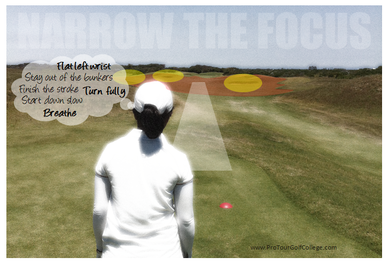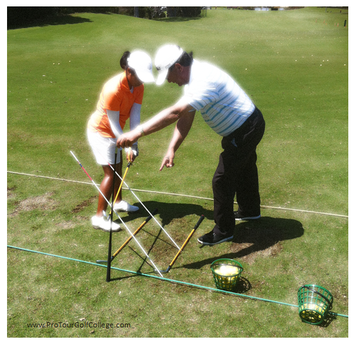How to Practice Golf: The Golf Swing Change Model That Will Help You To Play Better in Less Time5/4/2014
If you are a regular reader of our articles then you know that we freely share our thoughts, experience and our methods with you on how you can improve the way you practice and play golf so that you can achieve your golfing goals faster. David and I are in a fortunate position that we have been helping golfers of all ability levels day-in-and and-day-out for well over 20 years. When you spend this much time helping golfers to improve you start to notice consistent patterns in the way they go about trying to improve their game. Some of these patterns are helpful, but too often they are nothing more than a much longer way to achieve their goal. Strangely some golfers can find a way to take something that’s relatively simple to understand and do, and make it a lot more complicated. We often ask ourselves; "why do some golfers make this complicated game even more complicated?" Confusion reigns supreme in golf...still! We also find as golf instructors that the more time we spend searching for ways to improve our students the more we realize that it’s often just one simple principle applied thoughtfully and deliberately that seems to have the most influence on improved performance on the golf course.  The # 1 Golf Swing Change Principle Today more than ever there are so many options for you to improve your golf from experts from many different fields like; psychology, bio-mechanics, sports medicine and equipment technology and the practitioners from these domains all want to share their knowledge and experience with you, and help you to play better. But we continually find that regardless of the approach used, and who is teaching it, the key principle that has helped our golfers the most over many years of teaching is this one: Reduce the complexity and increase your competency The lure of the fast-track to golf success is ever present, and you need to realize that your ultimate success in golf is going to get down to whether you can stay focused on this key principle by reducing the distraction of trying to do too many things perfectly, rather than focusing on improving your weakest-most important golf skills; These are the high pay-off skills that drive performance up, and golf scores down. This simple principle say’s that the more complexity you introduce into your game, the more mistakes you will make, and the more mistakes you make, the longer it will take you to reach your golf goals. So how do you manage complexity in your golf game?  Click on the image to make it larger Click on the image to make it larger What is Golf Complexity? Complexity as it relates to golf improvement is the amount of elements that you are focusing on and managing as you swing the golf club, in order to achieve a particular goal. For example; imagine that you are standing behind your golf ball and preparing to walk into the ball to hit your shot. The timeline for your pre-shot routine is likely to be between 10 and 20 seconds from the walk in to the finish of your stroke. The key to successfully executing the stroke will get down to how few things you are able to think about prior to pulling the trigger. That's not so easy to do right? That’s right, it’s not easy to do because you are required to reduce all the “how to” thoughts you have down to one clear image and/or feel of what you want to do with the shot, and then execute it. Now if you have been working on complex swing changes, then this will make it really challenging for you because your mind has been exercising and making a habit of processing quite a few chunks of information.  One thought and one swing One thought and one swing Compounding Complexity Imagine that you are working on your golf swing with your instructor and your goal is to change your stroke pattern so that you can hit more effective shots under pressure. The key question here is how many elements within your stroke pattern can you think about and perform competently? My guess is not too many. In-fact, I doubt that you could think of two factors at the same time and execute your golf stroke without making a mistake. Now mistakes are a normal part of the pathway to mastery, however, the idea is to reduce the mistakes by employing simple methods that improve the way you strike the ball under pressure. We have found that the best way to do this is to reduce the amount of influencing factors (the complexity) in the method you use. The method is the practice drill, training aid or practice routine that takes the idea of change and turns it into reality. Remember that your goal should always be to increase skill competency by decreasing skill complexity. You should break your skill down into a smaller amount of information chunks that you completely understand, and then develop one part or chunk at a time.  Break the process down into smaller chunks Break the process down into smaller chunks Expediency is Your Enemy We know as golf instructors that you want to improve faster, but you can’t speed up the biological learning process unless you can simplify your approach to learning each part of the stroke pattern carefully and deliberately. The best you can hope for is that your golf instructor can design highly specific and relevant training drills and techniques that get to the core of your swing change, and that you apply them continually in an environment away from distraction. But even this is not enough. You need to have these chunks of information communicated to you in such a way that the outcome is that you learn each part correctly. If you don’t truly understand what you are trying to do, then you will surely have problems further down the road. If you don’t understand the process of change you are attempting to make, then it is likely to be more complex than it needs to be. Work with your instructor to make it simpler and easier to understand. Break the skill process down further and focus on the first change component.  Practical Practice Psychology So how can you practice your golf skills to accelerate change? The key is to realize that what you are fundamentally doing is changing behavior. The only way we know to accelerate swing change behavior is to start by reducing the major distractions in learning and improving golf, and the major distraction that tops the list is focusing on the target when you shouldn't be. That’s right, focusing on trying to hit perfect golf shots to a target whilst managing multiple swing thoughts is highly complex, and a guaranteed recipe for disaster. It's also the slow track to golf swing change. Ideally you should start with a swing change model like ours (below) that gets you to ask the important questions about what you need to do, and how long you will need to do it for, to create a new habit. Changing a golf stroke pattern successfully requires that you do these four things; 1. Allocate time each day to perform the stroke change process 2. Receive the information relating to the change component so that you understand it completely 3. Perform with pre-designed relevant drills, aids and routines performed with the correct amount of stroke volume 4. Determine the timeline when your practice goes from a technique focus to a target focus It’s essential that you understand that by increasing the number of components that you attempt to change within your golf stroke the more complex it becomes. More components equals a higher amount of mistakes, and with a higher amount of mistakes, the longer it will take you to change the stroke pattern.
If you are working on golf swing changes with your instructor make sure that you use our simple golf swing change chart as a guide to help you change your stroke successfully.
Pro Tour Golf College is Opening in Indonesia in 2014
We will be opening our National Golf Training Centre at Emeralda Golf Course in July and inviting serious amateur and professional golfers aged 10 to 30 to train part time and full-time in our world class programs. For expressions of interest please contact us at [email protected]
Scott Lieber
6/4/2014 11:47:29 am
You guys have some of the best and most practical insights into performance I have seen. I have been a professional coach for over 25 years and you information is some of the best I have seen. Keep up the great work. 7/4/2014 01:04:24 am
Thank you Scott, Comments are closed.
|
Archives
June 2019
|
Proudly Supported By
Copyright © 2011 - 2018 Pro Tour Golf College
Website Managed By Golf Performance Media
All Rights Reserved
Website Managed By Golf Performance Media
All Rights Reserved






 RSS Feed
RSS Feed



